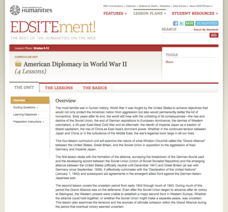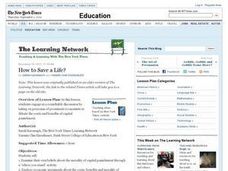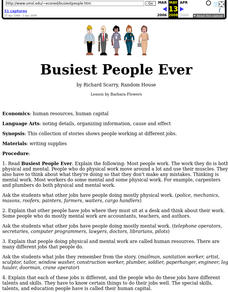Curated OER
1912: The Election that Changed the Century
The presidential election of 1912 was a turning point in American politics. Whoever won would reshape the political spectrum. Learn about the key issues, each party's politics, and the four men who wanted to become president: William...
Curated OER
Lesson: Urban China: Contemporary China
The urbanization and consumerism of modern China is the hot topic up for critical analysis. Kids view a series of photographs that specifically describe Chinese modernization, urbanization, consumerism, and waste. They discuss each...
National Endowment for the Humanities
“Twelve Years a Slave”: Analyzing Slave Narratives
Readers of Solomon Northup's brutally frank slave narrative Twelve Years a Slave examine passages that support the argument that slavery "undermined and corrupted" the institution of marriage. Background information is provided by a...
Global Oneness Project
Exploring Cultural Sustainability
Small groups learn about a present-day nomadic culture in Mongolia and the threats to its existence by exploring a photo essay. The resource includes thoughtful discussion and writing prompts about cultural sustainability, the...
PBS
Women's History: Parading Through History
Want to teach your pupils about debate, effective speech techniques, propaganda, and the women's movement? The first in a sequential series of three, scholars analyze real propaganda images from the the historic women's movement, view a...
Curated OER
Design a Coin
Students research a state and then design a quarter for it. They use dough or foil to create the coin! students explore state quarters that have already been issued by the U.S. Mint. Their quarter is for a state that hasn't had one...
Curated OER
Olympic Challenge
Have your class research a country related to the Olympics. They participate in physical education activities included in the Presidential Physical Fitness Test and write about their country. This is a very interactive plan.
Curated OER
India: Is Terrorism Hurting the Economy?
Students investigate the effect of terrorism on the Indian economy. They conduct research on terrorist activity in India, create a timeline, and participate in a summit between Indian and Pakistan.
Curated OER
Navajo Sand Paintings
Research the use of sand paintings in the Navajo tribe. Your students work together to design their own sand painting. They share their creation with the class describing what the symbols mean.
National Endowment for the Humanities
American Diplocmacy in World War II
The end of World War II saw the world deeply changed over the last few years. Four thorough lessons explore post-war Europe, America, and Asia through reading assignments and discussion questions about the Grand Alliance and the signing...
Smithsonian Institution
POWs
Why did Vietnam POWs and their families receive more media attention than POWs in previous wars? To answer this question, class members view artifacts, read articles, and engage in class discussion. Individuals then assume the voice of...
Curated OER
Classical Greece - Alexander the Great and His Legacy
If you are studying Ancient Greece, this presentation on Alexander the Great would be an excellent addition to your lessons. The PowerPoint is packed with information about Alexander the Great's contributions to Greek society, and what...
Humanities Texas
A President's Vision: George Washington
Who knew that one poster about George Washington could have so many learning possibilities attached to it? Here you'll find an attractive learning display on the first president of the United States, as well as worksheets and...
Humanities Texas
A President's Vision: Theodore Roosevelt
Through an engaging, interactive experience analyzing primary sources, invite your young historians to take a closer look at the presidency of Theodore Roosevelt.
Humanities Texas
Primary Source Worksheet: Franklin D. Roosevelt, First Inaugural Address
Young historians will learn not to fear primary source materials (or fear itself, for that matter) thanks to this resource that uses Franklin D. Roosevelt's March 4, 1933 Inaugural Address to model how to conduct a close reading of such...
Cave Creek Unified School District
Crusades and Culture in the Middle Ages
The Crusades sounds like a glamorous time period in the Middle Ages full of glory—but was it? Scholars find and review the truth of the Crusades' influence on the world through the resource. The study guides, separated individually by...
Smithsonian Institution
Cuban Missile Crisis
The United States—specifically John F. Kennedy—played a large role during the Cuban Missile Crisis. A history resource poses questions that encourage critical thinking as well as in-depth analysis of images from the time period.
Japan Society
The Bubble Economy and the Lost Decade
Explore Japanese society and national identity. Class members share ideas about the Japanese economy and then investigate a series of resources, including an article, a film, a lecture, and a poem, to learn about Japan's Bubble Economy...
Curated OER
Resources of the Three Little Pigs
Second graders, after listening to the The Three Little Pigs, identify the natural, human, and capital resources involved in creating each house.
Curated OER
How To Save a Life
Students examine their own beliefs about the morality of capital punishment through a "where you stand" activity. They explore economic arguments about the costs, benefits and morality of capital punishments by reading and discussing...
Curated OER
Busiest People Ever
Students write a paragraph about what they want to do when they grow up. They include the special skills and education (human capital) they must have to do the job they've chosen.
Curated OER
How Resourceful Are You?
Students examine the Nevada state quarter and discuss items on the quarter, categorizing them as natural resources, human resources, or capital resources. They paste other coins into correct categories depending on the resources depicted...
Curated OER
Is Capitalism Good for the Poor? | How Incentives Affect Innovation
High schoolers focus on the role played by a nation's institutions in generating creativity, invention and innovation, and analyzes how innovation promotes the economic growth that raises standards of living and alleviates poverty.
Curated OER
Is Capitalism Good for the Poor? | No More Slide Rules – The Costs and Benefits of Innovation
Students brainstorm a list of the benefits that Americans at all levels of society have enjoyed as a result of innovations in rail transportation/computers/microprocessors. They write a response from President Jackson to Martin Van Buren...
Other popular searches
- Socialism and Capitalism
- Socialism vs Capitalism
- Capitalism Socialism Communism
- Socialism Capitalism

























